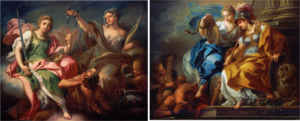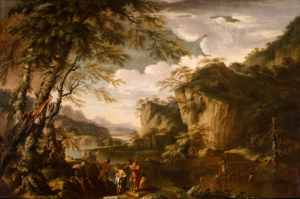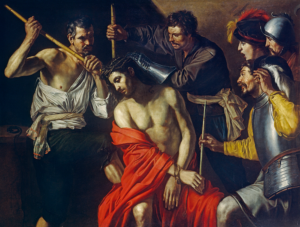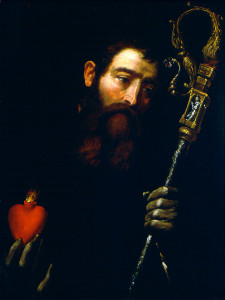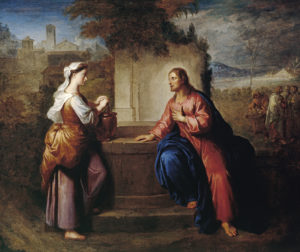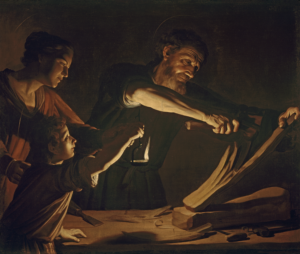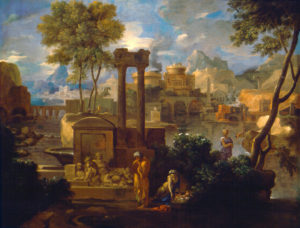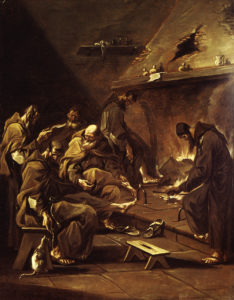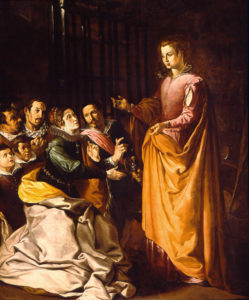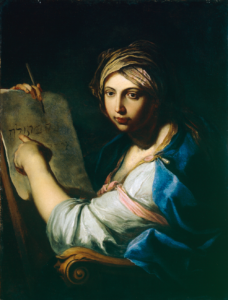Justice and Temperance Overcoming Vice
Prudence and Fortitude Overcoming Evil
Oil on canvas
Sebastiano Conca
Roman, 1680–1764
Click on the links throughout the article to view additional artists’ works and reference material.
Although born in Gaeta, Italy in 1680, Sebastiano Conca received his early training in Naples as a student of Francesco Solimena. Conca’s teacher followed the style of his great Neapolitan predecessor, Luca Giordano as well as Giovanni Lanfranco and Mattia Preti, all of whom are represented in M&G’s collection.
Sebastiano eventually moved to Rome (along with his brother Giovanni) in 1706 to begin his own practice. He remained in Rome for about 45 years rising in popularity and becoming one of the most sought after artists of his day. Some of his most notable patrons included Cardinal Pietro Ottoboni, various members of the royal families of Spain, Portugal, and Poland, and even Pope Clement XI himself. He returned to Naples, his artistic roots, around 1752 where he remained the rest of his career. Considered his best work, the Coronation of St. Cecilia adorns the ceiling of the nave of the Basilica of St. Cecilia in Rome.
His style evolved from the Giordanesque influence of his early teacher, Solimena, to Baroque classicism and eventually the Rococo for his smaller works. He was not only an artist, but he was also twice the director of the Accademia di San Luca, a teacher (one of his most notable students being Pompeo Batoni), and a published author.
This pair of small, cabinet paintings appear to derive from four, large wall paintings Conca created for the Palazzo Lomellini-Balbi-Lamba-Doria in Genoa. While the four large works each feature an individual Virtue, these smaller pendants present them in pairs. Richard P. Townsend notes, “the painter’s combinations are particularly appropriate: prudence should always inform fortitude and justice should be dispensed with temperance.”
The four Cardinal Virtues are the foundation on which all others rest: Justice, Temperance, Prudence, and Fortitude. Artists and authors alike portray these virtues as women. Conca’s personification of the four Cardinal Virtues appears to be loosely based on Cesare Ripa’s Iconologia, which was the primary resource for many artists active in the seventeenth and eighteenth centuries looking to personify virtue and vice.
Here Conca draws symbols from three different types of justice described in Ripa’s book. Justice sits on the left with her symbolic scales used to weigh and measure the two sides of a court case. The crown on her head and sword in her hand show her power and authority to execute the verdict. Resting beneath her lies the fasces (a group of wooden rods bundled together with an axe-blade protruding), the emblem of authority for magistrates in ancient Rome.
To the right, Temperance reclines holding a bridle by which she reigns in affections and passions with moderation and self-control. Clutched in the opposite hand, she holds a palm frond, a sign of victory in Roman culture. She is often portrayed tempering wine with water a task carried out by an angel in this work.
Crushed between them lies Vice, an immoral behavior or negative character trait. Together Justice and Temperance overcome Vice, depicted here by hiding her true face with a mask of deceit.
Aristotle describes prudence as “right reason applied to practice.” Conca’s Prudence features two characteristic attributes: a mirror and serpent. A mirror allows for self-examination from multiple angles. It reveals the truth about oneself. The serpent alludes to Matthew 10:16 where Christ tells the disciples to be “wise as serpents, and harmless as doves.”
Fortitude, “strength of mind which enables one to bear adversity with courage,” sits beside Prudence, clothed in armor and holding a shield by which she is prepared to battle Evil. Fortitude is often portrayed near or leaning on a column which lends her support (in reference to the Biblical Samson). Her spear shows her “superiority gained by strength,” and the lion resting by her side expresses strength and courage.
An angel holds Evil bound with a chain at their feet showing the triumph of Prudence and Fortitude over Evil.
Rebekah Cobb, Guest Relations Manager
Published in 2016
